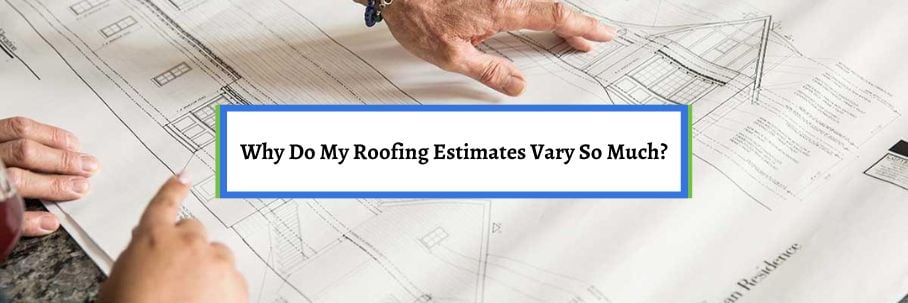Why Do My Roofing Estimates Vary So Much?

So, you got two or three roof estimates for your upcoming roof replacement, which is great for determining which roofing company is right for you. However, it’s always shocking to see the differences in the prices.
After all, they all looked at the same roof. How is it possible for the roofing estimates to vary this much?
For over 30 years, the team at Bill Ragan Roofing has helped homeowners understand the “whys” of the roofing industry. Because of this, I’ll break down why roofing estimates vary in pricing.
In this article, I cover the following:
- Why do my roofing estimates vary so much?
- 5 things to compare when looking at multiple roof estimates
Why do my roofing estimates vary so much?
Roofing estimates simply vary so much because every roofing company is different. However, there are two big reasons why roofing estimates vary so much on the pricing.
Different costs associated with each specific roofing company
Most roofing estimates vary because every roofing company has different overhead costs, labor costs, and/or uses specific materials because they believe in the product. If a roofing company is established in your area and has a physical office location, company vehicles, and a full team of employees, chances are their prices will be higher.
On the other hand, most newer roofing companies’ prices are a lot cheaper because they lack a lot of overhead. I’m not saying that an older company is better than a newer one because there are very good young roofing companies.
However, roofing companies shut down every day because they don’t know how to retain earnings to get through the slow months. A more established roofing company simply ensures they'll be around to take care of your roof investment five years from now if a problem pops up.
A roofing contractor trying to win your business with a low price
Now, we need to talk about the dark side of the roofing industry and why some estimates are much cheaper than others. Trust me when I say this, roofing contractors can smell when you’re looking for the cheapest price.
Because of this, some companies leave off necessary materials, use low-quality materials, or use a different material (like using 3-tab asphalt shingles as ridge capping) to cut down their costs to beat out the competition. There’s also a good chance they’ll be using cheap labor.
That’s not to say a lower-priced estimate is wrong or a roofing company is trying to take advantage of you. But when one roofing estimate is much lower than the other, there are ways to spot the reasons why.
5 things to compare when looking at multiple roof estimates
Now you know why roofing estimates vary so much. As I just said, you need to dig into why the estimates vary so much.
Luckily, there are things you can compare to ensure you’re not getting taken advantage of by either roofing contractor. Let’s break down the 5 things to compare when looking at multiple roof estimates.
1. Every line-by-line item included in the roof estimates
The very first thing you need to compare is each roof estimate’s line-by-line items. These items are everything that will be included in your roof replacement, from the roofing materials to dump fees to the roofing contractor’s labor and much more.
If it impacts the cost of your new roof, it should be included as a line item in your estimate. When comparing the line items, make sure they include the same specific information to see why the different roofing companies charge a lower or higher price.
For example, there should be a line item for tarps to protect your landscaping, pool, or other areas during the roof replacement process. While it adds to the cost, it shows the roofing contractor is taking the appropriate precautions to protect your property.
If one company has this as a line item and the other doesn’t, you’ll need to consider if the cheaper price is worth potential property damage. This is just one example, but it shows how doing things the right way can cost more.
That’s why it’s important to ask any potential roofing contractor why their estimate is missing a line item that’s included in another.
2. The roofing materials and components
While these are part of the line items, you must also compare the roofing materials and components listed on the estimate. You need to ensure each estimate has the same list of components, not necessarily the brand.
Every roof estimate should include the following materials and components:
- Drip edge
- Underlayment
- Ice and water shield
- Roof flashing and pipe boots
- Starter shingles (if asphalt shingle roof)
- Shingles (or other roofing material)
- Ridge capping
- Roof vents
Every item above should be included in every roof estimate. The specific brands and manufacturers don’t necessarily need to match up, but the materials and components do.
But if you want the best quality roof and material warranties, you should ensure all of the roofing components come from one manufacturer to form a complete roof system. If you notice a mixture of different generic manufacturers, the estimate will be significantly lower, and it'll show in the final quality after installation.
Remember, some roofing contractors leave off necessary materials or use a different material to cut down their costs to beat the competition. So, if your estimate lacks any information related to the list above, don’t even consider hiring them.
3. How the different roofing companies handle replacing rotten decking
Roof decking is a crucial roofing component that is the foundation of your entire roof system. But while it’s a roofing component like the others in the list above, it may not necessarily need to be replaced like the others.
Unfortunately, a roofing contractor can’t determine how much roof decking needs to be replaced until your old roof is torn off. That’s why you need to compare how each roofing company handles decking if it needs replacing due to damage or rotting.
Some roofing companies include it as a line item that specifies how much it will cost per sheet to replace if rotten decking is found. In this situation, the roofing contractor should inform you how much and let you know it’ll show up on your final invoice.
On the other hand, some roofing companies include replacement decking in their original estimates. In this situation, you’ll pay for the decking materials whether they use them or not.
Both ways are reputable, as long as you know upfront what will happen if they have to replace any decking. Just know that if there’s nothing in the estimate about roof decking, there’s probably a hidden fee that makes their initial price look lower than the others.
4. How long of a workmanship warranty each roofing company offers
When getting a new roof, you’ll have warranties on the roofing materials and your roofing contractor’s workmanship. Each of your estimates should include information about the warranties, but the one you need to compare is how their workmanship warranty differs.
First off, every roofing contractor should offer a workmanship warranty. So, if your estimate doesn’t include one, don’t even think about hiring them.
With that in mind, the length of a workmanship warranty varies from contractor to contractor. If a roofing contractor does things the right way, they should have no problem standing behind their work for at least 10 years.
However, it’s always a good idea to set your standards higher by looking for a roofing company that offers a lifetime warranty or close to it (25 years).
5. The details in the fine print of each roof estimate
Just like every other contract, you need to read the fine print on your roof estimate. It provides crucial information that tells you a lot about a roofing company and how they do things.
That’s why you should always compare the fine print details in each roof estimate. For example, one of the most important things to compare is how each roofing company handles damage to your property.
Some companies hide in their fine print that they're not responsible for damage to things like your gutters, light fixtures, sprinkler heads, and even things hanging in your home. They’ll also have exclusions that revolve around setting up protection for things on your property, like covering your pool and landscaping.
If they do this, they're leaving out a crucial part of the replacement process. At the end of the day, a roofing company hiding things in the fine print without explanation means they’re probably not the most reputable company in your area.
What roof estimate red flags should you look to avoid being taken advantage of by a roofing contractor?
After reading this article, you now know why your roof estimates vary and how to compare them to determine the differences. Doing this is a great way to ensure you’re on your way to making the right hiring decision.
Unfortunately, the roofing industry has a bad reputation for a reason. So, there’s a chance the estimates could still be full of red flags without you realizing it.
The last thing I want is for you to get taken advantage of by the roofing industry. That’s why I wrote another article that helps you spot these red flags.
Check out 5 Red Flags to Look Out for on Your Roof Estimate to avoid being taken advantage of by a roofing contractor.


